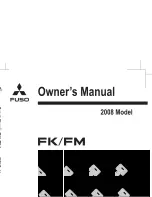
BRAKES 5A-12
Figure 10— Power Cylinders Installed
The vacuum source on gasoline engine models
is the engine intake manifold.
The combination of vacuum in front of the
diaphragm and atmospheric pressure behind the
diaphragm results in the power application of the
brakes.
VACUUM POWER BRAKE
SYSTEM TESTS
V A C U U M T E S T
With engine stopped, hand brake applied and
transmission in neutral, apply brakes several
times to destroy all vacuum in system.
Depress brake pedal, and while holding foot
pressure on pedal, start engine. (It m ay be neces
sary to pump pedal two or three times to build up
pedal reserve.) If vacuum system is operating,
pedal will tend to fall away under foot pressure
when engine starts, and less pressure will be re
quired to hold pedal in applied position. If no action
is felt, vacuum system is not functioning.
Inspect vacuum lines for leakage, and for re
striction caused by bent or kinked tube or hose.
If no fault is found in lines, trouble is in power
cylinder control valve, necessitating overhaul of
power cylinder.
H Y D R A U L IC T E S T
Stop engine and again destroy all vacuum in
system. Depress brake pedal and hold foot pres
sure on pedal. (It may be necessary to pump pedal
two or three times to build up pedal reserve.) If
brake pedal gradually falls away under foot pres
sure hydraulic system is leaking, either intern
ally or externally.
Inspect all hydraulic line connections for leak
age and make the necessary repairs. If no external
leaks are evident, inspect master cylinder and
wheel cylinders and replace parts as necessary.
If the condition still exists, an internal leak in
power cylinder is indicated, necessitating over
haul of power cylinder.
POWER CYLINDER REPLACEMENT
The installed location of vacuum power cyl
inders varies by model (see fig. 10).
Conventional - behind cab step, immediately
below left hand door. Vacuum reserve tank is lo
cated in this same area, when used.
Tilt Cab - between frame side rails in front
of the radiator and behind the front bumper.
R E M O V A L
1.
For easier accessibility, it is recommend
ed that cab step be removed on conventional models
and that cab be tilted forward on tilt cab models.
CHEVROLET SERIES 70 -80 H EAVY DUTY TRUCK SH O P M A N U A L
Summary of Contents for 70 1969 Series
Page 1: ...CHEVROLET HEAVY DUTY TRUCK SHOP MANUAL...
Page 3: ......
Page 11: ...LUBRICATION 0 4 CHEVROLET SERIES 70 80 HEAVY DUTY TRUCK SHOP MANUAL...
Page 27: ......
Page 119: ......
Page 361: ......
Page 371: ......
Page 427: ......
Page 443: ......
Page 451: ......
Page 493: ......
Page 499: ......
Page 549: ......
Page 555: ......
Page 609: ......
Page 715: ...am...
Page 745: ......
Page 910: ......
Page 913: ......











































